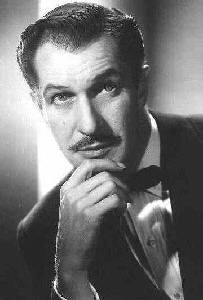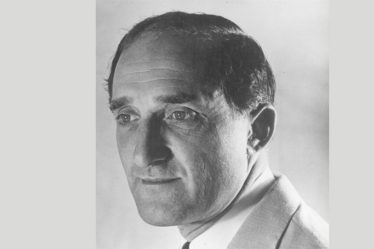
WARNING: This Article May Contain Spoilers
Born: 27th May 1911
Died: 25th October 1993 (age 82)
The man that could be called the Star of Gothic Horror, Vincent Leonard Price, Jnr. (although as both his father and grandfather were both Vincents he could have officially been Vincent Price III) came from a well to do family; his grandfather invented Dr. Price’s Baking Powder; who, when he was old enough, could afford to send him to many of Europe’s cultural cities – this travelling is probably where he honed his eloquent tones. He attended school in St Louis, Missouri and summer school in Connecticut before graduating from Yale with a degree in English and a minor in Fine Art. At the age of 23 he travelled to England to study for a Master in Fine Art at the Courtauld Institute of Art but was drawn towards the stage, which became his first love. His film debut did not come for another ten years. His first step into the horror genre was at the age of 35, when he starred in Joseph L. Mankiewicz’s Dragonwyck, and it was in this category that he seemed to have found his niche; his work with Roger Corman on his Edgar Allen Poe adaptations are probably what he was most noted for Horror wise.
The Ten Commandments tops Vincent Price’s top five, no surprise as epics like this where a big thing at the time – very rarely now will anyone go to the cinema for a three hour plus film, very few directors are making them – but the thing about biblical epics, such as The Ten Commandments, is they are like watching Shakespeare – eloquently written and dramatic – and Baka, the master builder, is the perfect role for Price’s powerful articulation. It’s a small role, in comparison, yet he does not disappoint. Tim Burton was so lucky to actually get Vincent Price to appear in Edward Scissorhands but what a shame he was so ill with his COPD and Parkinson’s that he could only manage a couple of small scenes. Yet as The Inventor, creator of Edward, Price comes across as a loving ‘father’ – his history of horror films fits the film but not quite the role I am used to is him being the villain so was nice to see another side. Edward Scissorhands was to be Price’s last onscreen cinema appearance. Now for his third film at bit of history first – Marie Tussaud, the lady behind Madam Tussaud’s wax museum, started her ‘collection’ by making death masks and full wax body casts of famous victims of the French Revolution – well House of Wax takes it to another level! Vincent Price plays the sculptor Professor Henry Jarrod a talented empathetic man at the start of the film who loses his beloved waxwork museum through a fire. By the end of the film he is a twisted man. The contrast between the two is perfect even his ‘façade’ is unwavering even if you know the outcome you start to question whether he is involved. I love a decent waxworks, there used to be a really good on the Isle of Wight, with a Chamber of Horrors that creeped me out as a kid, but the idea of this film makes you question how many of these lifelike statues are just wax!
The Great Mouse Detective is as you’d expect Disney’s answer to Sherlock Holmes and very good it is too. Firstly I was never expecting Vincent to do an animation especially with his back catalogue of horror and secondly I was expecting him to be the bad guy, Professor Rattigan, but I wasn’t expecting the singing – and very good he is too! The animation is very Price; the exaggeration on some moves is very theatrical you can almost picture him standing there doing the same movements and this is a 2D animation no motion capture here so congratulations to the animators for making the character so realistic to the actor. Back to one of his earlier films for his fifth; Leave Her to Heaven sees Price playing jilted lover Russell Quinton, what I at first thought was a small part and barely recognised him – he’s not his usual gaunt self and his voice is deeper – but it is not until the final scene where he comes into his own with a commanding performance as a prosecuting attorney – he hits hard every time with every word he eloquently speaks.
Pop Quiz: Which 80s song has the opening lines – “It’s close to midnight, And something evil’s lurking in the dark”? That’s right Michael Jackson’s Thriller but did you know (until now that is considering who this article is about) that Vincent Price recorded the spoken bit at the end of the song – “Darkness falls across the land, The midnight hour is close at hand…” – this song was probably some people’s first encounter of this horror great but not mine as I was very lucky growing up to have had a TV in my room, not everyone I grew up with did, so one of my guilty pleasures was to watch the late night horror that was shown and part of that became my introduction to Mr Vincent Price through his Dr Phibes character. There was something I loved about the way he portrayed Phibes that drew me to him, I mean anyone that can portray a character that doesn’t talk (without being plugged into his machine) with only facial expressions and still convey his emotions is brilliant – in his first Phibes film (he made two in all) there is no conversation for about the first ten minutes! I said earlier that in Edward Scissorhands it was nice to see Price’s “other side” but if you look at Phibes and his other horror chracters he plays them all gently, there is no over exaggeration of the villainous evil, and there is a hint of lightness around the edges maybe even a little smile plays at the corners of his mouth in some characters.
As well as being an award winning actor Vincent Price was also an art lover and collector and he served on many Arts committees including the Fine Arts Committee for the White House. He was a gourmet chef and wrote several cook books with his second wife. During the McCarthy Trials* in the 1950s Price was ‘greylisted’ for having been a ‘premature anti-Nazi’, he struggled to find work for a while because of it. Vincent was married three times and had two children. He died of lung cancer at his home in Los Angeles in 1993.
*McCarthy Trials – a series of investigations and hearings during the 1950s in an effort to expose supposed communist infiltration of various areas of the U.S. government. The term has since become a byname for defamation of character or reputation by means of widely publicized indiscriminate allegations, especially on the basis of unsubstantiated charges.


